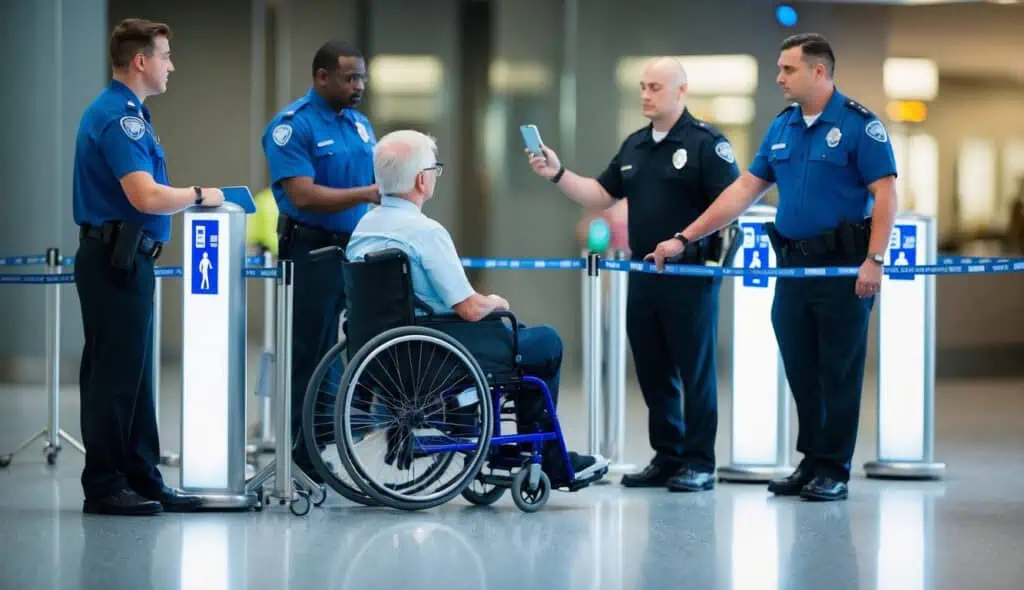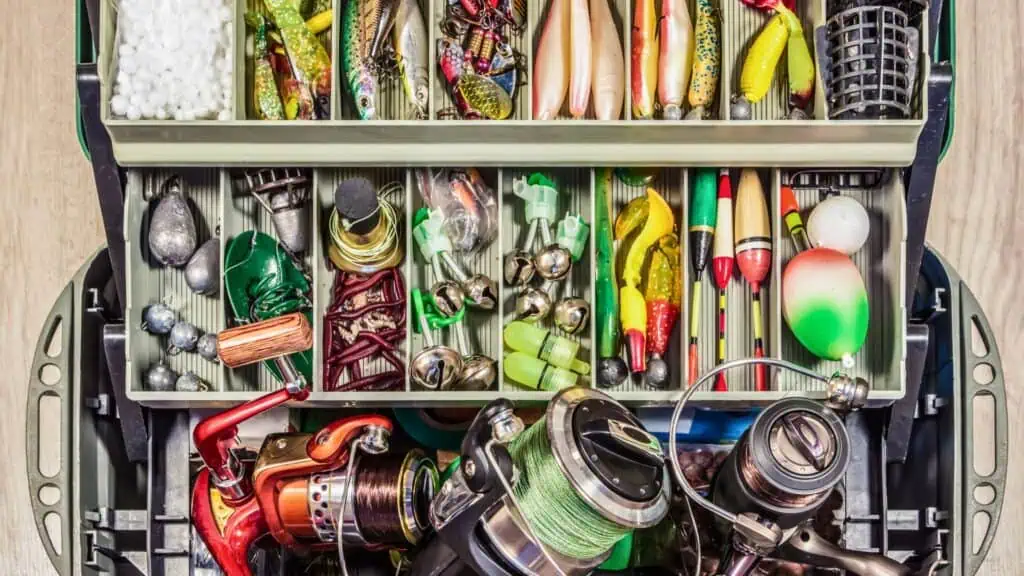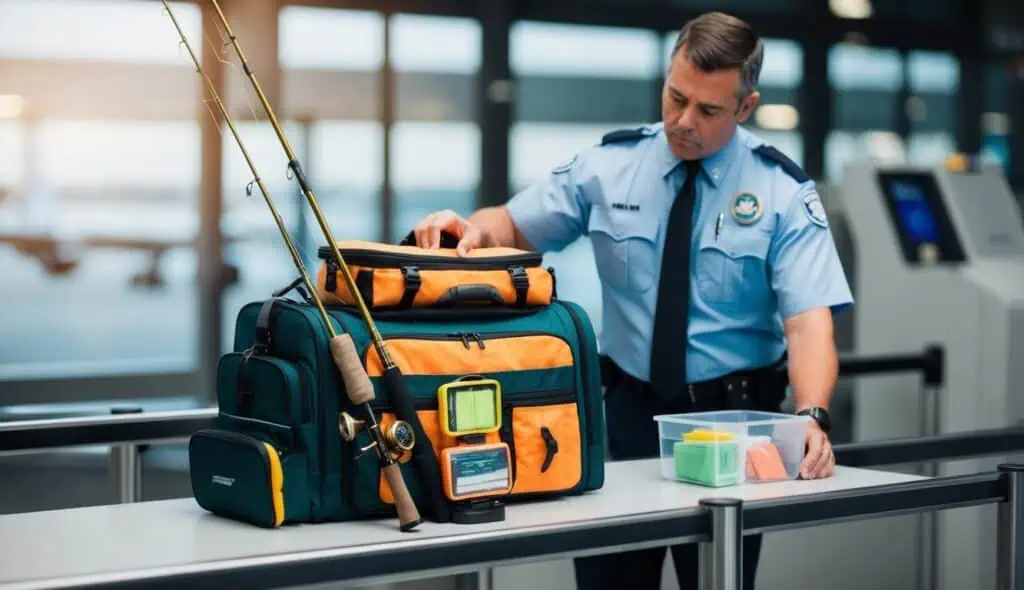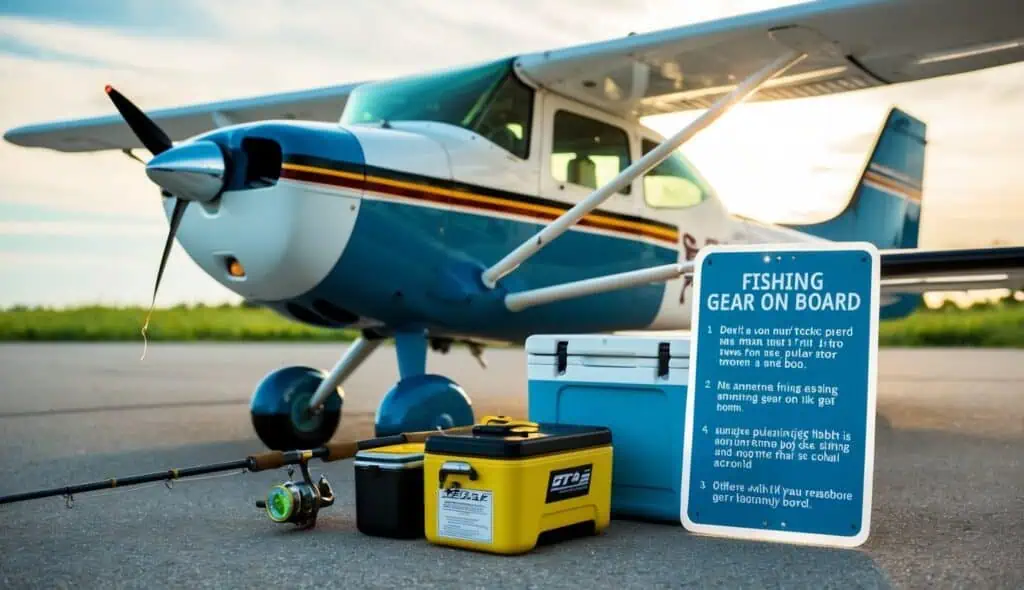Bringing your fishing gear on a plane can be tricky, but it’s doable with the right preparation. Airlines have specific rules about what fishing equipment you can pack and how to do it safely.
You can usually bring fishing rods, reels, and tackle boxes on planes, but you need to follow size and weight limits.

Packing your gear properly is key to a smooth trip. Put sharp items like hooks and knives in your checked luggage. Consider using a hard-sided case for your rods to protect them during travel. It’s also smart to label your equipment with your name and contact info in case it gets lost.
Before you fly, check your airline’s website for their exact rules on fishing gear. This will help you avoid surprises at the airport. Remember to give yourself extra time for security checks, as fishing equipment might need special screening. With these tips, you’ll be ready to bring your fishing gear along on your next flight.
Contents
Airline Regulations for Fishing Gear

Airlines have specific rules for fishing gear. These cover checked bags, carry-ons, and international flights. Knowing these rules helps you travel smoothly with your gear.
Checked Baggage Policies
Most airlines let you check fishing rods and reels. Pack them in hard cases to protect them. Rods can be longer than normal luggage size limits. You can often bring one set of gear as a single checked item. This usually includes:
- 2 rods
- 1 reel
- 1 landing net
- 1 pair of fishing boots (in a case)
- 1 tackle box
Check with your airline for exact rules. Some may charge extra fees for oversized items.
Carry-On Restrictions
You can often bring small fishing items in carry-on bags. These might include:
- Reels
- Small lures (without hooks)
- Line
- Flies
Hooks and sharp tools must go in checked bags. This is particularly true of fishing knives which will not be allowed in the cabin.
Rods are usually too long for carry-on. Some airlines might allow collapsible rods that fit in overhead bins.
Always pack valuable gear in your carry-on if possible. This keeps it safe and close to you.
International Flights Considerations
Rules for fishing gear can change when you fly to other countries. Some things to keep in mind:
- Check import rules for your destination
- Some places restrict certain types of bait or equipment
- You might need to declare your gear at customs
- Clean your gear before travel to avoid spreading invasive species
It’s smart to research local fishing laws before you go. This helps you avoid issues at the border. Some countries require fishing licenses or permits for visitors.
Types of Fishing Gear and Transportation Guidelines

Packing fishing gear for air travel requires knowing what’s allowed and how to pack it safely. Different types of equipment have specific rules and best practices for transportation.
Rods and Reels
Most airlines let you bring fishing rods and reels on planes. Pack rods in hard cases to protect them. Take apart multi-piece rods and wrap each section in bubble wrap. Put reels in your carry-on bag if possible. Remove fishing line from reels to avoid tangles.
Airlines often count fishing gear as one item:
- 2 rods
- 1-2 reels
- 1 tackle box
Check your airline’s size limits. Some allow rods up to 115 inches long without extra fees.
Hooks, Lines, and Sinkers
Pack hooks, lines, and sinkers in your checked luggage. Put hooks in hard plastic containers or wrap them in cloth. This keeps them from snagging other items. Coil fishing line neatly to avoid tangles.
Place sinkers in a strong, sealed container. Their weight can damage other gear if not packed well. Label the container “Fishing Weights” to help security screening.
Baits and Lures
You can bring most baits and lures on planes. Pack them in your checked bags. Wrap soft plastic lures in plastic bags to keep them from melting or sticking to other items.
Put hard lures in tackle boxes or wrap them to protect their hooks. Live bait isn’t allowed on planes. Freeze-dried or preserved bait is okay, but pack it well to contain any odors.
Check rules for your destination. Some places have strict bait import laws to protect local ecosystems.
Packing Tips for Fishing Equipment

Proper packing keeps your fishing gear safe and organized during air travel. Follow these tips to protect your equipment and make the most of limited space.
Protecting Your Gear
Use a hard-sided fishing rod case to shield your rods from damage. Wrap reels in bubble wrap or soft cloths before placing them in your luggage. Put sharp hooks in a small plastic container with a secure lid. Pad the container with cotton balls to prevent hooks from moving around.
Store lures in tackle boxes with divided compartments. This keeps them from tangling or getting damaged. Put any liquids like fish attractants in leak-proof containers and seal them in plastic bags.
For fragile items, use clothing as extra cushioning in your suitcase. Socks work well to protect smaller gear pieces.
Compact Packing Strategies
Roll up fishing line and store it in empty pill bottles or small tupperware containers. This keeps it tangle-free and easy to access.
Use vacuum-sealed bags to compress soft items like waders or rain gear. This frees up space for bulkier equipment.
Pack multi-purpose tools to save room. A Swiss Army knife with pliers and scissors can replace several single-use items.
Nest smaller items inside larger ones. Put leader material and sinkers in an empty reel spool, then place the spool in your tackle box.
Choose collapsible gear when possible. Folding nets and telescoping rods take up less space in your luggage.
Security Screening Procedures
Knowing what to expect at airport security can make your trip smoother when bringing fishing gear. TSA has specific rules for handling fishing equipment. Proper preparation will help you pass through screening quickly.
TSA Guidelines for Fishing Gear
TSA allows fishing poles as carry-on items. They don’t count toward your luggage limit. Pack reels, small lures, and flies in your carry-on bag. Put large hooks and sharp objects in checked luggage.
Wrap hooks securely to prevent injury. Use hard cases for expensive reels. Label tackle boxes clearly. Remove knife tools from your tackle box before flying.
TSA may need to open your gear for inspection. Be ready to explain any unusual items. Follow agent instructions if they need a closer look at your equipment.
Preparing for Security Checks
Pack your fishing gear neatly to speed up screening. Use clear plastic bags for small items like hooks and lures. This makes them easy to see and check quickly.
Keep your fishing license handy. TSA might ask to see it. Have a list of what’s in your tackle box. This can help if questions come up during screening.
Arrive at the airport early when bringing fishing gear. You might need extra time for security checks. Be patient and polite with TSA staff. They’re doing their job to keep everyone safe.
Handling Fees and Insurance

Bringing fishing gear on a plane can add extra costs and risks. Knowing about fees and insurance options helps you plan and protect your equipment.
Extra Baggage Costs
Many airlines charge extra for fishing gear. Fees can range from $25 to $150 per item. Some airlines count fishing rods as special items with their own fees.
Check your airline’s policy before booking. Some allow one set of fishing gear as a regular checked bag. Others may charge even if it’s your only bag.
Pack smart to avoid oversize or overweight charges. Break down rods and reels if possible. Use a travel case designed for fishing gear to stay within size limits.
Insurance for Fishing Gear
Standard travel insurance often doesn’t cover expensive fishing equipment. Consider getting special coverage for your gear.
Some options include:
- Adding a rider to your homeowners or renters insurance
- Buying a separate policy for sporting equipment
- Getting coverage through fishing or outdoor organizations
These policies can protect against loss, theft, or damage during travel. Costs vary based on the value of your gear and coverage limits.
Take photos and keep receipts of your equipment. This helps if you need to make a claim. Some policies require you to list high-value items separately.
Remember to check the deductible and coverage limits before buying. Make sure the policy covers your gear’s full value.
Destination-Specific Fishing Gear Rules
Different places have their own rules for fishing gear. You need to check local laws before you travel with your equipment. This helps you avoid problems and fish legally at your destination.
Freshwater vs. Saltwater Equipment
Freshwater and saltwater fishing need different gear. Freshwater rods are often lighter and shorter. Saltwater rods are stronger to handle bigger fish. Reels for saltwater have special parts that resist rust. Lures and bait also vary between fresh and salt water.
Some spots only allow certain types of gear. You might need to use barbless hooks in some rivers. Other places ban live bait to protect local fish. Check if your gear fits the rules where you plan to fish.
Pack the right gear for your trip. Bring freshwater tackle for lakes and rivers. Pack saltwater gear for ocean fishing. Having the wrong equipment can ruin your fishing plans.
Invasive Species Regulations
Many places have strict rules about moving fish and plants. These rules stop harmful species from spreading. You must clean your gear before and after fishing in new waters.
Some areas require you to:
- Drain all water from boats and equipment
- Remove any plants or animals from your gear
- Dry everything completely before using it again
You might need to use special cleaning stations at some fishing spots. Some places even ban certain types of bait or fishing methods to protect local ecosystems.
Check local rules before you travel. You could face fines if you bring the wrong bait or dirty gear. By following these rules, you help keep fishing spots healthy for everyone.
Tips for Traveling with Expensive Gear
Protecting your valuable fishing gear during air travel is crucial. Taking steps to document, secure, and properly store your equipment can give you peace of mind and prevent losses.
Documentation and Valuation
Make a detailed list of your fishing gear before your trip. Include brand names, model numbers, and serial numbers when possible. Take clear photos of each item. Keep receipts for expensive items like rods and reels. Check with your insurance company about coverage for your gear while traveling. Some policies may require extra coverage for high-value items. Consider getting an appraisal for very expensive or rare equipment. Store copies of all documentation in multiple places – your luggage, carry-on, and the cloud.
Secure Storage Solutions
Invest in hard-sided cases for your rods and reels. Look for cases with foam inserts that can be customized to fit your gear snugly. Use padded rod tubes to protect individual rods. Wrap reels in soft cloth before packing. Pack hooks and lures in small plastic containers with dividers. Use a TSA-approved lock on your tackle box or gear case. Consider shipping very expensive or irreplaceable items to your destination instead of flying with them. Pack any tools or accessories separately in your checked luggage to comply with airline rules.
Frequently Asked Questions
Bringing fishing gear on planes involves specific rules and considerations. These common questions cover key aspects of traveling with various fishing equipment by air.
Can you bring fishing hooks on a plane as a carry-on item?
You can pack fishing hooks in your carry-on bag. The TSA allows them, but it’s best to wrap them securely. Sharp objects can pose risks, so careful packing is important.
What are the TSA rules regarding transporting fishing equipment on an aircraft?
TSA rules let you bring most fishing gear on planes. Rods, reels, and tackle boxes are allowed in carry-on and checked bags. Some items like sharp tools over 7 inches must go in checked luggage.
How can you carry fishing rods on a plane, and do different airlines have specific policies?
You can bring fishing rods as carry-on or checked items. Many airlines allow rods up to 7 feet long in overhead bins. Longer rods may need to be checked. Check your airline’s rules before flying.
Are there any special considerations for carrying fly fishing gear during air travel?
Fly fishing gear needs extra care when packing. Wrap delicate flies securely. Pack rods in protective cases. Some airlines may count fly fishing equipment as a special item, so ask about fees.
What are the costs associated with checking fishing rods on a flight?
Costs for checking fishing rods vary by airline. Some count them as standard checked bags. Others may charge extra for oversized items. Check your airline’s fee structure before your trip.
Is it permissible to bring fishing pliers in your carry-on when flying?
You can bring small fishing pliers (less than 7 inches) in your carry-on bag. Larger pliers must go in checked luggage. Always pack tools carefully to avoid issues at security checkpoints.

I have been traveling around the world by air since the early 70s and living overseas too. I worked for British Airways for a number of years and I am also a private pilot. About Me


